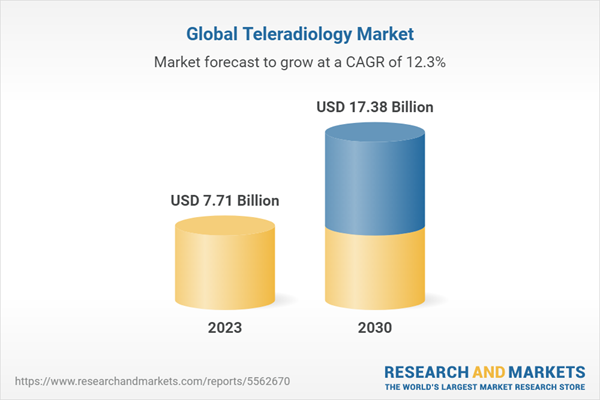Global Teleradiology Market is expected to grow with a compound annual growth rate (CAGR) of 12.31% between 2023 and 2030.
The shift from conventional film-based radiography to digital imaging has streamlined the remote transmission and interpretation of clinical images, facilitating steady and active sharing with teleradiologists for timely diagnoses. This transition has been driven by the growing call for radiological offerings, spurred by a growing elderly population and the growing occurrence of chronic ailments. Often, this demand outpaces the supply of on-site radiologists, necessitating teleradiology to bridge the gap. Teleradiology 24/7 availability ensures non-stop access to expert radiological services, vital in emergency and critical care situations where well-timed diagnosis and treatment are paramount.
Moreover, teleradiology networks facilitate connections among healthcare providers and specialized radiologists with information in sectors like neuroradiology or pediatric radiology, enhancing diagnostic accuracy and average patient care. This network additionally permits geographic enlargement, extending radiology services to underdeveloped or remote areas where radiologist shortages are common, thereby broadening access to quality healthcare. Also, teleradiology provides cost-efficiency for healthcare facilities, allowing entry to specialized expertise without the overhead fees associated with full-time radiologist recruits, making it an attractive and economically feasible alternative.
Similarly, governments globally understand teleradiology ability to enhance healthcare accessibility, particularly in underserved areas, leading to supportive rules and policies. The United States Medicare Telehealth Expansion Act of 2000 exemplifies this, extending Medicare insurance to teleradiology services and enhancing accessibility for beneficiaries. Simultaneously, technological advancements, particularly artificial intelligence integration, revolutionize teleradiology. AI streamlines image interpretation, workflows, and diagnostic accuracy, heightening performance. This combination of government backing and technological innovation underscores teleradiology pivotal function in expanding healthcare access and improving diagnostic abilities. Hence, the global teleradiology market size is valued at US$ 7.71 Billion in 2023.
Ultrasound has prominence in the global teleradiology market
Imaging Techniques, the Global Teleradiology Market is damaged into X-Ray, Computed Tomography (CT) Scan, Magnetic Resonance Imaging (MRI), Ultrasound, Nuclear Medicine, and Others. Ultrasound prominence in the global teleradiology market results from the growing need for robust healthcare services driven by advances in telecommunication technology. Its non-invasive and radiation-free nature, affordability and portability allow healthcare providers to reach underserved regions efficaciously, and its versatility and effectiveness in diagnostics align with the global trend toward safer and more patient-friendly healthcare solutions.Ultrasound's non-invasive, radiation-free traits are a favoured diagnostic tool across a broad spectrum of clinical situations, aligning with the worldwide shift toward safer and more patient-centric healthcare solutions. Furthermore, contemporary ultrasound machines, known for their portability and affordability, have amplified their utilization in telemedicine, permitting healthcare companies to attain underdeveloped or faraway regions.
Software is dominant in the global teleradiology market
By Technology, the Global Teleradiology Market is split into Hardware, Software, and Services. Software prominence in the global teleradiology market may be attributed to numerous vital factors and the simplification of image transmission and interpretation through the digitalization of medical imaging, an essential requirement for remote diagnostics. Also, the software program enables real-time access to patients' facts and photographs, fostering collaboration among healthcare specialists. Artificial intelligence and machine learning advancements enhance software programs' image evaluation capabilities, boosting accuracy and performance. Moreover, software program solutions are price-effective, scalable, and customizable, catering to various healthcare companies. This blend of technological prowess, accessibility, and adaptability solidifies software's preeminent role in the ever-expanding teleradiology services market.Diagnostic Center is substantially growing in the global teleradiology market
By End-Users, the Global Teleradiology Market is split into Hospitals, Ambulatory Surgical Centers, Diagnostic Centers, and Others. The substantial expansion of diagnostic centres in the global teleradiology service market stems from surging demand for remote healthcare services aided by advanced digital infrastructure and high-speed internet. This permits speedy image and data transfer, even as the combination of AI and machine learning bolsters diagnostic accuracy. Recent years have further increased telehealth adoption, propelling diagnostic centres as safe and efficient healthcare delivery solutions. In this dynamic landscape, diagnostic centres play a pivotal role, broadening access to high-quality clinical diagnostics and fueling the growth of the teleradiology market size.United States is significantly leading in the global teleradiology market
By Country, the Global Teleradiology Market is split into the United States, Canada, Mexico, Brazil, United Kingdom, Germany, France, Italy, Spain, Netherlands, China, Japan, India, South Korea, Australia, South Africa, United Arab Emirates, and Rest of the World. The US has continually led the global teleradiology market size because of early adoption, an adequately established healthcare system, high demand for radiologist shortages in faraway areas, and the need for round-the-clock coverage. Government help, exemplified through the Medicare Telehealth Expansion Act of 2000, furthers teleradiology's boom. The US's solid technological infrastructure underpins teleradiology implementation and hosts enterprise leaders like RadNet, Telerad, and vRad, imparting diverse services. Pioneering research and improvement led to modern technology, which includes AI-driven teleradiology systems, improving performance and accuracy.Key Players
The prominent players in the global teleradiology market include FUJIFILM Corporation, Koninklijke Philips, General Electric Company, Oracle Corporation, Siemens AG, GE Healthcare, and McKesson.This report titled “Global Teleradiology Market Global Forecast by Level of Imaging Techniques (X-Ray, Computed Tomography (CT) Scan, Magnetic Resonance Imaging (MRI), Ultrasound, Nuclear Medicine, and Others), Technology (Hardware, Software, and Services), End-User (Hospitals, Ambulatory Surgical Centers, Diagnostic Centers, and Others), Country (United States, Canada, Mexico, Brazil, United Kingdom, Germany, France, Italy, Spain, Netherlands, China, Japan, India, South Korea, Australia, South Africa, United Arab Emirates, and Rest of the World), Companies (FUJIFILM Corporation, Koninklijke Philips, General Electric Company, Oracle Corporation, Siemens AG, GE Healthcare, and McKesson)” provides a detailed and comprehensive insight of the Global Teleradiology Market size.
Imaging Techniques - Global Teleradiology Market breakup from 6 viewpoints:
1. X-Ray2. Computed Tomography (CT) Scan
3. Magnetic Resonance Imaging (MRI)
4. Ultrasound
5. Nuclear Medicine
6. Others
Technology - Global Teleradiology Market size breakup from 3 viewpoints:
1. Hardware2. Software
3. Services
End User - Global Teleradiology Market breakup from 4 viewpoints:
1. Hospitals2. Ambulatory Surgical Centers
3. Diagnostic Centers
4. Others
Country - Report covers 18 countries Teleradiology Market
1. United States2. Canada
3. Mexico
4. Brazil
5. United Kingdom
6. Germany
7. France
8. Italy
9. Spain
10. Netherlands
11. China
12. Japan
13. India
14. South Korea
15. Australia
16. South Africa
17. United Arab Emirates
18. Rest of the World
All companies have been covered from 3 viewpoints:
- Overview
- Recent Developments
- Revenue
Company Analysis:
1. FUJIFILM Corporation2. Koninklijke Philips
3. General Electric Company
4. Oracle Corporation
5. Siemens AG
6. GE Healthcare
7. McKesson
Table of Contents
Companies Mentioned
- FUJIFILM Corporation
- Koninklijke Philips
- General Electric Company
- Oracle Corporation
- Siemens AG
- GE Healthcare
- McKesson
Methodology
In this report, for analyzing the future trends for the studied market during the forecast period, the publisher has incorporated rigorous statistical and econometric methods, further scrutinized by secondary, primary sources and by in-house experts, supported through their extensive data intelligence repository. The market is studied holistically from both demand and supply-side perspectives. This is carried out to analyze both end-user and producer behavior patterns, in the review period, which affects price, demand and consumption trends. As the study demands to analyze the long-term nature of the market, the identification of factors influencing the market is based on the fundamentality of the study market.
Through secondary and primary researches, which largely include interviews with industry participants, reliable statistics, and regional intelligence, are identified and are transformed to quantitative data through data extraction, and further applied for inferential purposes. The publisher's in-house industry experts play an instrumental role in designing analytic tools and models, tailored to the requirements of a particular industry segment. These analytical tools and models sanitize the data & statistics and enhance the accuracy of their recommendations and advice.
Primary Research
The primary purpose of this phase is to extract qualitative information regarding the market from the key industry leaders. The primary research efforts include reaching out to participants through mail, tele-conversations, referrals, professional networks, and face-to-face interactions. The publisher also established professional corporate relations with various companies that allow us greater flexibility for reaching out to industry participants and commentators for interviews and discussions, fulfilling the following functions:
- Validates and improves the data quality and strengthens research proceeds
- Further develop the analyst team’s market understanding and expertise
- Supplies authentic information about market size, share, growth, and forecast
The researcher's primary research interview and discussion panels are typically composed of the most experienced industry members. These participants include, however, are not limited to:
- Chief executives and VPs of leading corporations specific to the industry
- Product and sales managers or country heads; channel partners and top level distributors; banking, investment, and valuation experts
- Key opinion leaders (KOLs)
Secondary Research
The publisher refers to a broad array of industry sources for their secondary research, which typically includes, however, is not limited to:
- Company SEC filings, annual reports, company websites, broker & financial reports, and investor presentations for competitive scenario and shape of the industry
- Patent and regulatory databases for understanding of technical & legal developments
- Scientific and technical writings for product information and related preemptions
- Regional government and statistical databases for macro analysis
- Authentic new articles, webcasts, and other related releases for market evaluation
- Internal and external proprietary databases, key market indicators, and relevant press releases for market estimates and forecasts

LOADING...
Table Information
| Report Attribute | Details |
|---|---|
| No. of Pages | 170 |
| Published | November 2023 |
| Forecast Period | 2023 - 2030 |
| Estimated Market Value ( USD | $ 7.71 Billion |
| Forecasted Market Value ( USD | $ 17.38 Billion |
| Compound Annual Growth Rate | 12.3% |
| Regions Covered | Global |
| No. of Companies Mentioned | 7 |









